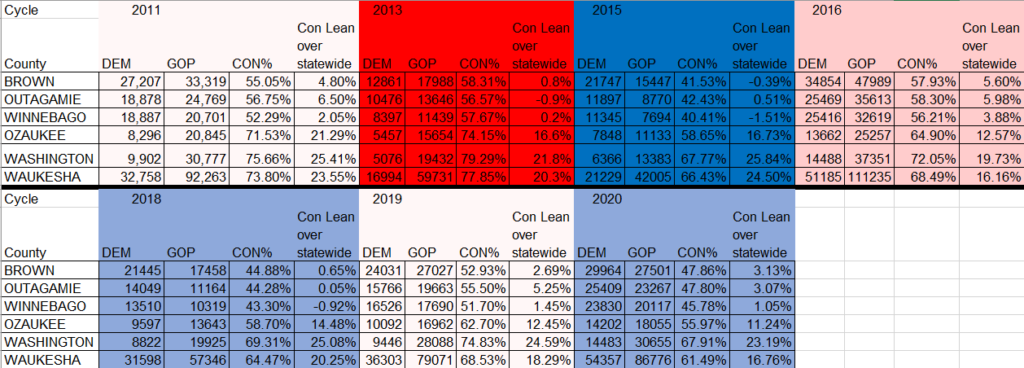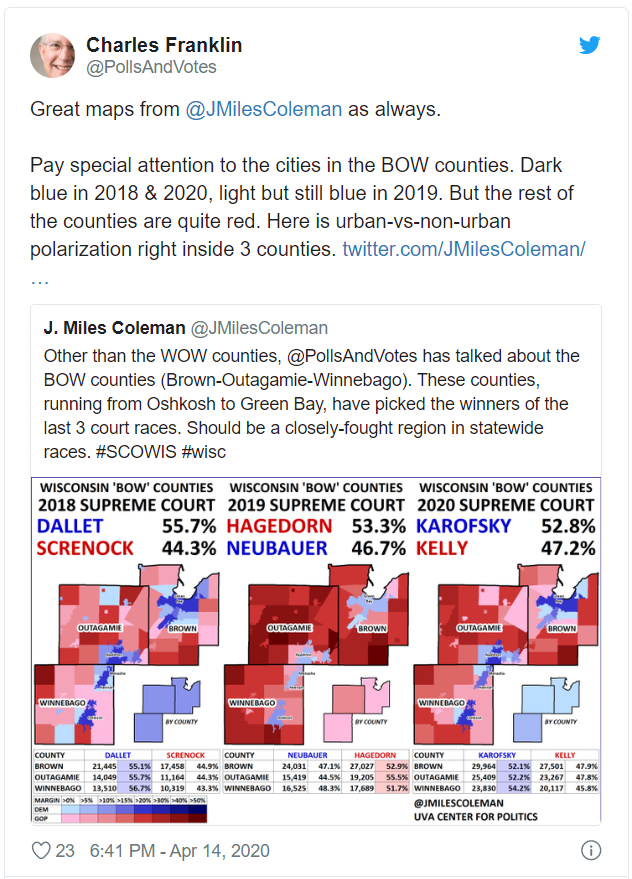On Monday, the results of the April 7th Spring Election and Presidential primary were revealed, county by county, as dictated by court order. For real political junkies the action wasn’t the Presidential primaries as they have already been decided, but rather the state’s infamously partisan Supreme Court elections. Judge Jill Karofsky defeated incumbent Justice Daniel Kelly by over ten points, a marked change from 2019’s narrow conservative victory.
In the aftermath of Monday, I’ve seen enough declarations and tea leaf reading to make even me blush. There are somethings worth looking at, but we must be careful not to point out trends or extrapolate on higher turnout being better for X or Y.
Let’s start with the “higher turnout = Democratic victory” folly. Yes, this most recent election saw the highest turnout in the spring since 2016. How have the total ballots cast correlated with liberal or conservative victories? Not very well.
In 2011, nearly 1.5 million ballots were cast- conservative Justice David Prosser won re-election by around 7,000 votes.
In 2013, turnout barely cracked 854,000, conservative Justice Patience Roggensack won re-election by over 128,000.
In 2015, turnout collapsed further, below 813,000 ballots, and liberal Justice Ann Walsh Bradley won re-election by 131,000.
In 2016, turnout exploded to the current record for a Supreme Court election- 1,957,947- as both parties had Presidential primaries. Conservative Justice Rebecca Bradley won re-election by over 95,000 votes.
In 2018, turnout was halved from 2018, barely cracking 996,000- and liberal judge Rebecca Dallet won the open seat vacated by a conservative judge by over 115,000 votes.
In 2019, turnout increased by over 200,000 from the year prior, with almost 1,207,000 ballots cast. Conservative judge Brian Hagedorn flipped the open seat held by a liberal judge by just under 6,000 votes.
Turnout this time was going to favor Democrats slightly because there was no Republican Presidential primary- only President Donald Trump’s name was on the ballot- which is why activists last year were so excited about the 2019 contest. Then, as DailyKosElections explained, liberal retainment of the seat would mean a narrow 4-3 conservative majority going into a 2020 cycle, and 2020 would give the left a chance to flip ideological control. Conservative activists in the state knew this too and pushed hard to flip despite being outspent- and they succeeded, briefly edging the conservative margin of the court to 5-2.
One could argue the changes at large in the neighboring WOW are a sign the Wisconsin suburbs are finally cracking, but I would urge caution on such an interpretation. After all, we can look at recent Supreme Court elections and see these counties’ Republican margins shrink when Democratic/liberal candidates have strong showings:

Countering my own bit of Devil’s advocacy, Ozaukee is worth keeping an eye on. In the beginning of the 2010s it would regularly post 40+ point margins, Washington and Waukesha haven’t seen nearly as great an erosion. Republicans in such a fiercely divided state need to shore up any advantage they have, so shrinkage in formerly reliable areas need their attention.
The BOW region is finally getting its due in mainstream press but has been a favorite topic of Election Twitter for years, as well it should- it breaks for the winner in close elections. In the very narrow Hagedorn victory of 2019, he carried all three. This time around, they voted to the right of the state, but Karofsky was victorious in all three. Marquette Professor Charles Franklin reflected on their significance (and DDHQ alum Miles Coleman’s maps) yesterday:

Another observation of mine- in the rural northern and western corners, we had signs of trouble for the conservatives pushing for Kelly- fewer absentee requests were made relative to voter registration than we had seen in the southeast.

While the heavy hitters for both parties punched above their weight in the end- Dane, Milwaukee, Ozaukee, Waukesha, Washington- a considerable chunk of red-leaning and favoring counties sported voters not taking advantage of vote-by-mail. Since Republicans are dependent on winning a majority of rural and exurban counties to carry Wisconsin, that sign should have been worrying.
Some conservatives anticipated those voters would just show up as tradition on election day- but with a pandemic, you can’t expect voters to gallop to the polls. Considering a sizable share of the Republican voter demo skews older, a virus that is particularly lethal to the elderly is a formidable deterrent to voting in-person. Republicans and conservative activists will need to take mail-in efforts as seriously as their Democratic counterparts in these conditions or face more losses like Monday.
Lastly, Dane County has seen a population explosion in recent years, and as it has grown, its vote has moved further and further leftward. The obvious sign on Monday evening of Kelly’s doom came when Dane reported just its suburban portions as forty-plus-point Karofsky victories before a single Madison precinct had rolled in. Karofsky crushed Kelly in Dane by over 123,000 votes. Every cycle has seen that margin grow, to the point that the conservative WOW no longer comes close to negating it. Worse than losing ground in W-O-W, or treading water in B-O-W, or even facing a task of reaching and compelling rural voters to participate, is this vote deficit. Dane isn’t showing any signs of slowing down in growth, so Republicans will need to become somewhat competitive here- climbing back up to at least a quarter of the vote- to stay competitive in statewide races.
The areas of improvement for Republicans are obvious, the opportunities for Democrats in November quite too. We’ll know who, in the next few months, paid better attention to them.